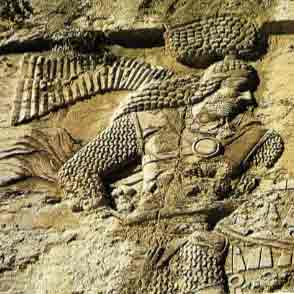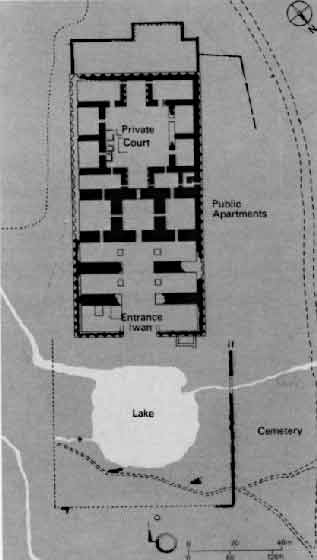|
Series:
Visual Essays Author:
Jamshid Varza
(Slide
Show)
Subtopics:
Background
Architecture
Conclusion

Ardeshir in Bas Relief commemorating his victory near Firuzabad.

Aerial plan of Ardeshir's palace near
Firuzabad. |
In this issue
of Visual Themes, I shall take our readers to a historic site on the
outskirts of the town of
Firuzabad.
Firuzabad,
which means the place of victory, is an ancient town about sixty
kilometers south of Shiraz in the province of Fârs
in central Iran. The province of Pârs
(or Fârs)
is the birthplace of two ancient Iranian Zarathushti dynasties: a) The
Acheamenians founded by Cyrus the Great, and b) The Sassanians, founded by
Ardeshir son of Papak.
Ibn
Istakhri, a Muslim Iranian historian, mentions this site as a fire temple
of great importance built during the Sassanian dynasty. Other scholars,
historians, and archeologists report this site to be the palace built by
Ardeshir during late Parthian or early Sassanian times. Whichever proves
to be true, this site is certainly a monument to the daring personality of
Ardeshir, the founder of the Sassanian dynasty.
Background
The conquest of Persia by Alexander (330 BCE) did not totally extinguish
the sacred fire. The minor Princes of
Pârs
in particular had preserved intact the traditions of the magi of the
Achaemenid period. One of them called Papak who was a petty king of Khir,
east of Shiraz, and whose father, Sassan, had fulfilled priestly functions
at Istakhr, capital of the kings of Persis, had begun to increase his
domain at the expense of his neighbors.
One of
Papak’s sons was Ardeshir, for whom he had obtained a high military post
in the town of
Dârâbgird.
Ardeshir, who had
conceived the
ambitious project of recapturing the power of the Achaemenids for himself,
took several towns in the province, defeating and killing the reigning
princes. He put down a revolt which had broken out in the region in his
charge and asserted his power by conquering the province of Kirmân.
Having succeeded his father in the capacity of priest-king, master of the
whole province of Pârs and Kirmân, he had a princely palace built at Gur
(present-day Firuzabad).
This
excited the jealously of Ardeshir’s sovereign, the Arsacid Ardawan-V (Artabanus),
and caused discord between the King-of-Kings and his subject, as a letter
from Ardawân to Ardeshir testifies: "You wretched Kurd, how did you
dare to build such a royal residence?" Ardeshir, so the story
goes, revolted against his sovereign and slew him with his own hand. After
this battle, which took place in 224 AD, Gur was called Ardeshir-Khurra
"Glory of Ardeshir." In 226AD, Ardeshir entered Ctesiphon, the southern
capital of the Parthian Empire.
During the next few years Ardeshir conquered Media, and attacked Armenia
and Azerbaijan. He subdued Sistân, Khurâsân, the land of Marv, Khwarazmia
and Margiana. The king of Kushans, the master of the valley of Kabul and
Punjab recognized his sovereignty. So five and a half centuries after the
fall of Achaemenid Empire, the Persians had reconquered their Iranian
domain and a new oriental empire had been created which could treat with
the Roman Empire on an equal footing. |